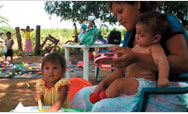Biodiversity in Latin America and the Caribbean
The Latin America and Caribbean (LAC) region includes five
of the world’s ten most biodiverse countries –
Brazil, Colombia, Ecuador, Mexico, and Peru – as well
as the single most biologically diverse area in the world
– the eastern slope of the Andes.
The region is home to approximately 27 percent of the world's
mammals, 34 percent of its plants, 37 percent of its reptiles,
43 percent of its birds, and 47 percent of its amphibians.
Forty percent of the plant life in the Caribbean is found
nowhere else on earth.
The natural environment, including biodiversity, provides
the primary social safety net for the rural populations of
the LAC region and is one of the few forces limiting malnutrition
and massive urban migration. In addition, biodiversity has
important economic value. For example, Guatemala’s revenues
from biodiversity-related sources including tourism and timber
and non-timber forest products (e.g., nuts, herbs, etc.) are
estimated at over $50 million annually, and Ecuador has earned
more than $100 million per year from nature-based tourism
in the Galapagos.
However, LAC biodiversity is under severe threat. Five of
the 15 countries whose fauna is most threatened with extinction
are in Latin America – Brazil, Mexico, Colombia, Peru
and Ecuador. In more than 60 percent of LAC region, coral
reefs are threatened and much of the region’s mangroves
have been lost due to coastal development, overfishing, marine
pollution, runoff from deforestation and farming, and industrial
and urban pollution.
Training and Support
Strategies vary by country, but in general USAID’s biodiversity
programs seek to:
- Build local, national, and regional skills to manage and
conserve biological diversity, including the ability to
identify and address critical threats to the sustainable
use forests and coastal resources;
- Foster greater public awareness of conservation issues;
and
- Develop and implement models of income generation that
are consistent with biodiversity conservation.
This training and support can include the following:
- Help foreign governments, non-governmental organizations,
and communities to develop the skills to better manage protected
areas;
- Support for outreach and environmental education programs;
and
- Work with communities, non-governmental organizations,
and governments to develop environmental policies and management
practices that conserve biodiversity while sustaining local
livelihoods.
USAID LAC at Work
Parks in Peril
Over the past decade, Parks in Peril -- USAID’s biodiversity
conservation program in Latin America and the Caribbean has
improved the natural resource management at 45 parks and protected
areas in 17 countries, totaling more than 28 million acres.
In the process the program has leveraged more than $290 million
in funding from other partners and strengthened more than
25 local non-governmental organizations to the point that
they are national voices for environment. Read
more...
Initiative for Conservation in the Andean Amazon
The Initiative for Conservation in the Andean Amazon (ICAA) is a 5-year program (2006-2011) that brings together the efforts of 20 public and private organizations working in the Amazon regions of Bolivia, Colombia, Ecuador, and Peru, with the goal of building constituencies and agreements that promote the sustainable use and conservation of biodiversity and environmental services of the region.
Learn more from the ICAA website.
Many USAID LAC country and regional programs address biodiversity conservation, including:
- Brazil
- Bolivia
- Colombia
- Ecuador
- Peru
- Panama
- Jamaica
- USAID Regional Environmental Program for Central America (PROARCA)
Back to Top ^
|


